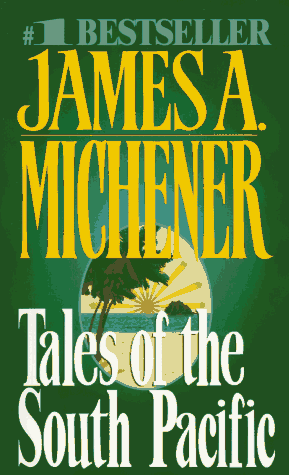This book was one of the reasons I started on this readiing journey: watched “South Pacific” the movie in December 1997 and watched the live musical in April 2010 and loved ‘em both. It helped that there were reviews like this one, talking about how the musical was fundamentally about the defeat of racism.
View Around the World in 80 Books in a larger map
So it was weirdly disconcerting to find myself wading into a piece of fiction that's anchored firmly in the world of racism:
"Right now I can see it. Some sawed-off runt of a Jew in Dachau prison. Plotting his escape. Plotting to kill the guards. Working against the Nazis. One little Hebrew. You probably wouldn't invite hm to your house for dinner. He smells. So futile. One little Jew. But by God, I'm for him. I'm on his side, commander."

But in fact, it's clear by the end that Michener is against racism. It's not just the famous set-to-music short stories in this collection that are proof of this: Lt Joe Cable tortured over the taboo of marrying the Tonkinese girl Liat on Bali-Hai; Ensign Nellie Forbush refusing, then agreeing to marry the miscegenating French plantation owner Emile Debecque.
Check out the final story, "A Cemetery at Hoga Point": the main character whom the narrator encounters is a Negro man (yes, that's how he's described) talking in classic drawlin' Southern dialect about how there wont be a good man to replace the old Commander Hoag, killed in Guadalcanal: instead, they've got loud-mouthed bully commander in his place who calls people niggers and kikes and grease balls (that's what the Italian boys get called).
Remember, the book came out in 1946. KKK was just starting to enjoy a post-war revival. Interracial marriage was illegal in many states.
And yes, we do have a tale of a happily married interracial couple: the naval officer Tony Fry and the half-French half-Javanese lady Latouche Debecque (an elder daughter of plantation owner Emile, who also surreptitiously runs the whorehouses). They actually get married, no freaking out or nothin'. No need for a lawyer: they have a Buddhist ceremony.
But I shouldn't let the themes detract from the prose. This book deserves its Pullitzer: its best stories are really riveting, and the structure - short fictions with recurring characters, so that we truly feel as if we've gained a glimpse into the many realities of life in the New Hebrides in World War II - is something I'd really like to try for myself someday.
And yes, there's sex and violence. (Sadly, every time Bloody Mary says "fuck", it's transliterated as "soandso" in italics. 1946. What can you expect? And speaking of Bloody Mary, it's intriguing how nativeness is feminised here - not a single indigenous/Asian immigrant man among the characters.)
Hmm, not a very coherent post today. Haven't even begun to talk about the geographical range this book covers: Noumea, Norfolk Island, Guadalcanal (Solomon Islands), Fiji even, maybe.
But the most memorable of the tales happen in Vanuatu - a name of an independent nation that' isn't mentioned once in the text. And it's Vanuatu that gets to advertise to tourists that the island of Ambae is the original Bali-Hai.
Huh. I've been pretty lucky, so far: every single book I've read so far has been a winner in some way or another. Let's see what happens as I move on.
Representative quote:
(this one's about the old Tonkinese souvenir vendor, Bloody Mary, in "Fo' Dolla'")
"Stand up like a man, and tell them to go to hell, Mary," the old, tough Marines would tell the old, tough Tonk. Mary would grin, not understanding a word of what they were saying, but after they came to see her for many days in a row the old miracle of the subdued races took place again. The yellow woman learned dozens of white words but the white men learned not one yellow word.
Next book: Sudesh Mishra's "diaspora and the difficult art of dying" from Fiji
1 comment:
bher341kioi
supreme outlet
golden goose outlet
golden goose outlet
golden goose outlet
golden goose outlet
golden goose outlet
golden goose outlet
golden goose outlet
supreme outlet
golden goose outlet
Post a Comment